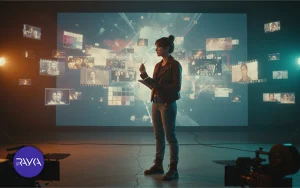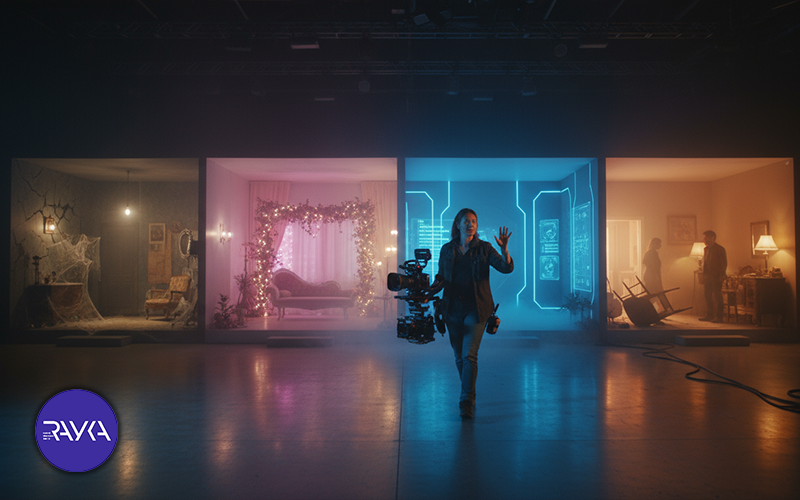
In the filmmaking process, “color psychology in cinema” is one of the most powerful tools for guiding audience emotions without any dialogue. It strengthens the atmosphere and theme of the story and creates a unique visual experience. When used intentionally in set design, costumes, lighting, and visual grading, colors enable filmmakers to act as “architects of emotion,” drawing the audience deeper into the narrative.
In filmmaking, color psychology refers to the intentional selection of colors to influence audience emotions and enhance the narrative. Colors are not just visual components; they are one of the core elements of production design. They can carry hidden messages, reflect a character’s emotional state, and shape the viewer’s overall experience.
Beyond aesthetic value, colors subconsciously evoke emotions such as calmness, anxiety, excitement, or tension. For instance, cool tones may create a sense of distance or detachment, while warm colors evoke intimacy or energy.
For example, in The Sixth Sense, the color red is used as a foreshadowing device for supernatural elements. In Traffic, the director uses different color palettes for each subplot, creating distinct visual and psychological atmospheres.
Colors in cinema are not merely decorative; they are among the most powerful emotional and narrative tools. Understanding color psychology helps directors and production designers add depth to each frame and influence emotional reactions more precisely. Many master filmmakers, such as Quentin Tarantino and Wong Kar-wai, use colors as a “second language,” subconsciously guiding the viewer through the story. The importance of color includes:
Each color carries a specific emotional message that must be considered in set design, costume design, and character development.
Red symbolizes power, passion, danger, and love.
It is one of the strongest narrative colors, immediately drawing attention. It conveys excitement, energy, and sometimes violence. In Schindler’s List, the little girl’s red coat symbolizes lost innocence, while in action films like John Wick, red is used as a color of vengeance and strength.
Black represents mystery, power, and the unknown.
It is frequently used for complex, intense, or enigmatic characters. Combined with low light, black enhances fear or sorrow. In The Dark Knight, Batman’s predominantly black costume conveys strength and seriousness. In horror films, black often forms the foundation of a dark and unsettling visual atmosphere.

Blue symbolizes calmness, sorrow, and introspection.
In films, blue often evokes silence, melancholy, and inner reflection. Directors such as Denis Villeneuve and Christopher Nolan frequently use blue palettes to deepen the emotional and philosophical layers of their stories. Blue Valentine is a prime example of how blue conveys heartbreak and emotional withdrawal.
Pink represents love, softness, and dreaminess.
It creates a sweet and gentle atmosphere and is often used in romantic, comedic, or youth-oriented films. For instance, in Barbie (2023), pink is the core visual identity of the film, crafting a whimsical and cheerful world that feels unreal yet delightful.
Yellow expresses energy, joy, and curiosity.
It instantly catches the viewer’s eye and evokes optimism and adventure. In Kill Bill, Uma Thurman’s yellow suit symbolizes passion, power, and focus. However, when combined with darker tones, yellow can also convey anxiety and instability.
Green symbolizes nature, growth, and sometimes jealousy.
In cinema, green has dual functions: in adventure and sci-fi films, it symbolizes life or advanced technology; in drama, it may reflect jealousy, corruption, or emotional tension. In The Great Gatsby, the iconic green light represents hope and unattainable dreams.
White stands for purity, honesty, and liberation.
It is often used to express innocence or spiritual moments. In The Revenant, the use of white light and snow symbolizes redemption and the cleansing of the protagonist’s spirit. White is also used to separate dreamlike spaces from reality in fantasy films.
Colors are selected in each genre to evoke the appropriate emotional atmosphere.
Every cinematic genre has its own emotional language, and colors help filmmakers deliver these emotions subconsciously. Choosing the right palette can be the difference between an ordinary film and a powerful one.
Cool and muted colors to evoke sadness, depth, and realism.
Drama films aim to provoke empathy and contemplation. Thus, blue, gray, and soft browns are used to convey sorrow, inner conflict, and realism. In Manchester by the Sea, the cold palette reinforces the film’s somber mood.
Bright and vibrant colors to create joy and playfulness.
Comedies use yellow, pink, orange, and light green to enhance energy and optimism. These colors evoke happiness, laughter, and comfort. The Intern is a great example of using cheerful colors to support a friendly and uplifting tone.
Bold and contrasting colors to convey excitement and intensity.
Action films often rely on red, black, and silver to communicate danger, strength, and tension. Red symbolizes anger and high energy, while black conveys seriousness and visual suspense. Mad Max: Fury Road uses a high-contrast blend of orange and blue to heighten excitement.
Dark and cold tones to evoke fear and anxiety.
Horror films typically use black, deep red, gray, and swampy greens to build eerie and unsettling atmospheres. In The Conjuring, low-light and shadowy tones intensify the feeling of realism and terror. The combination of black and dark red warns the viewer of imminent danger.

Neon and metallic colors to express futurism and technology.
Here, cool blues, fluorescent greens, purples, and silvers are used to evoke advanced technology, alien environments, and futuristic worlds. In Blade Runner 2049, neon colors contrasted with dark spaces represent isolation and artificial progress.
AI can assist in color palette selection and visual harmony across scenes.
Today, AI is more than a tool for visual effects; it’s used for color analysis, emotional palette creation, and visual cohesion. By analyzing hundreds of successful films in each genre, AI algorithms determine which color combinations have the strongest emotional impact on viewers.
Modern AI systems can recommend the best color tones based on genre, location, lighting, and even costume textures—ensuring that scenes remain both natural and emotionally powerful.
AI is also transforming color grading (post-production), helping editors maintain visual consistency. Tools like DaVinci Resolve AI and Colorlab AI automatically adjust colors to match the emotional tone of each scene.
Rayka Mah combines filmmaking expertise with artificial intelligence to lead in cinematic color design.
By using AI and color psychology, RaykaMah helps directors and brands design film and teaser color palettes based on the emotional profile of their target audience. With deep experience in AI-based filmmaking and cinematic projects, RaykaMah selects palettes that preserve visual beauty while creating direct emotional resonance with viewers.
Using advanced technology, RaykaMah can simulate color and lighting before production begins; allowing directors to preview how each palette transforms the mood of the film. This approach saves time, reduces costs, and enhances artistic coherence.
AI algorithms analyze visual and emotional data to recommend the best palette for each scene and genre.
In modern filmmaking, AI acts as a tool for emotional analysis and adaptive color generation. Using machine learning and visual data interpretation, these systems understand how each color affects the human mind and when it delivers the strongest emotional effect. AI color-analysis methods include:
Color psychology is a powerful tool that deepens the viewer’s emotional experience. Colors not only shape visual mood and aesthetic but also communicate emotional and symbolic meaning without dialogue.
With a proper understanding of color psychology, filmmakers can precisely reflect characters’ inner states, guide the audience’s attention, and create a unique visual identity.
And with AI-driven technologies, filmmakers can now analyze color data, predict emotional responses, and build visually cohesive scenes with unprecedented accuracy, creating richer, more memorable cinematic experiences.